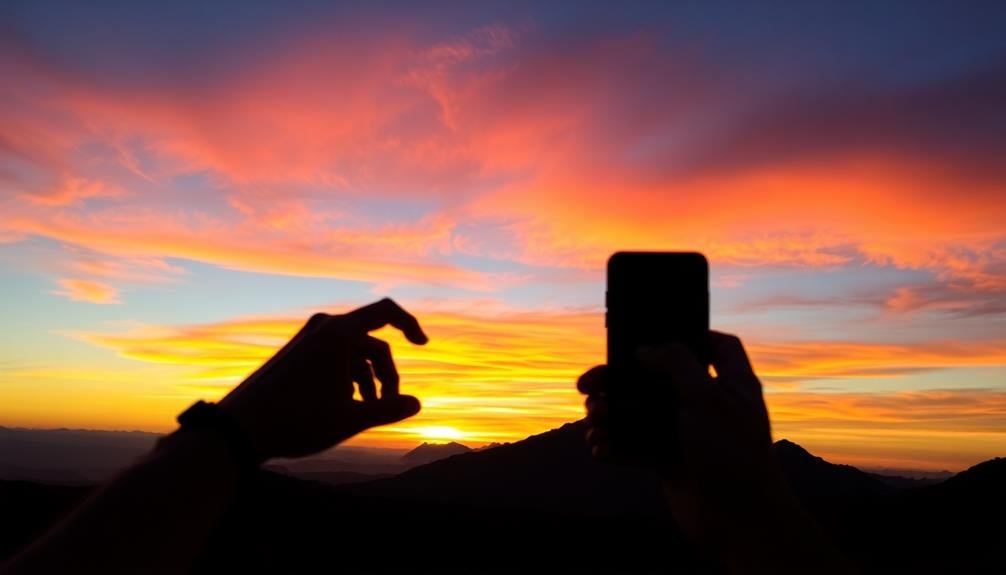To capture stunning landscapes with your mobile wide-angle lens, embrace foreground elements to add depth and interest. Leverage dramatic skies by positioning the horizon low and using HDR mode for balanced exposure. Utilize leading lines like roads or shorelines to guide the viewer's eye through the image. Don't shy away from unusual perspectives; try low angles or high vantage points for unique compositions. Finally, balance your shots with symmetry, using gridlines to align elements precisely. These techniques will elevate your landscape photography, transforming ordinary scenes into enchanting visual stories. Exploring these tips further will reveal even more potential in your wide-angle shots.
Embrace Foreground Elements

When using a wide-angle lens on your mobile device, incorporating foreground elements can dramatically enhance your compositions. Foreground elements add depth, scale, and visual interest to your shots, leading the viewer's eye into the scene. Look for rocks, flowers, branches, or other objects that can frame your main subject or provide a point of reference.
To make the most of foreground elements, get close to them. Wide-angle lenses exaggerate perspective, making nearby objects appear larger and more prominent. This effect can create a sense of immersion and draw attention to details that might otherwise go unnoticed. Experiment with different angles and positions to find the most compelling arrangement.
Consider the relationship between foreground elements and your background. Aim for complementary shapes, colors, or textures that create harmony in your composition. Use the rule of thirds to place foreground elements off-center, creating a more dynamic image.
Don't be afraid to get low to the ground or try unusual perspectives to emphasize foreground elements. Remember, the goal is to use these elements to enhance your overall composition, not overshadow the main subject.
Capture Dramatic Skies

A wide-angle lens offers an excellent opportunity to capture dramatic skies in your mobile photography. When using this lens, you'll be able to include more of the sky in your frame, creating a sense of vastness and drama. Look for interesting cloud formations, colorful sunsets, or stormy weather to add impact to your shots.
To make the most of dramatic skies, position the horizon line in the lower third of your frame. This composition technique allows you to emphasize the sky and its features. Don't be afraid to experiment with different angles; try pointing your camera upwards to capture even more of the sky's expanse.
Use your phone's HDR mode to balance the exposure between the bright sky and darker foreground elements. If your device has manual controls, you can also adjust the exposure compensation to prevent the sky from being overexposed. Consider using filters or editing apps to enhance the colors and contrast in your sky shots.
Timing is essential when capturing dramatic skies. The golden hour, just after sunrise or before sunset, often provides the most stunning lighting conditions.
Be patient and wait for the perfect moment when the sky's colors and cloud formations align for a truly enchanting image.
Use Leading Lines Effectively

Leading lines are a powerful compositional tool that you can leverage with your mobile wide-angle lens. These lines guide the viewer's eye through the image, creating depth and drawing attention to your main subject. With a wide-angle lens, you'll find it easier to incorporate more of these lines into your frame.
Look for natural leading lines in your environment, such as roads, fences, shorelines, or rows of trees. Position yourself to align these elements so they lead toward your focal point. You can also use man-made structures like bridges, railings, or architectural features to create strong lines.
When composing your shot, consider placing your main subject at the point where the leading lines converge. This technique will create a sense of movement and direction in your image. Experiment with different angles and perspectives to find the most compelling composition.
Remember that leading lines don't always have to be straight. Curved or winding paths can add a sense of mystery and intrigue to your landscape photos. Use your wide-angle lens to capture the full sweep of these curves, creating a dynamic and engaging image.
Experiment With Unusual Perspectives

Wide-angle lenses offer a unique opportunity to explore unconventional viewpoints. Don't settle for eye-level shots; instead, challenge yourself to find fresh angles that captivate viewers.
Get low to the ground and shoot upwards to emphasize foreground elements and create a sense of scale. This technique works particularly well with flowers, rocks, or other interesting objects in the immediate vicinity.
Alternatively, climb to a high vantage point and aim downwards to capture sprawling landscapes from above. This bird's-eye perspective can reveal patterns and textures that aren't visible from ground level. Try holding your phone at arm's length above your head or use a selfie stick for an even higher angle.
Experiment with tilting your phone to create dynamic diagonal compositions. This can add energy and movement to your images, especially when combined with strong lines or patterns in the scene.
Don't be afraid to break the rules of traditional composition; sometimes, an off-kilter horizon can make your shot more intriguing.
Lastly, consider incorporating unusual framing elements like tree branches, doorways, or rock formations to add depth and context to your wide-angle shots. These natural frames can guide the viewer's eye and create a sense of discovery in your images.
Balance Composition With Symmetry

Symmetry can be a powerful tool when composing wide-angle shots. It creates a sense of balance and harmony that's visually appealing to the human eye. When using your mobile wide-angle lens, look for naturally occurring symmetrical elements in the landscape. Reflections in calm water, mirrored architectural features, or even a perfectly centered path can all serve as focal points for symmetrical compositions.
To achieve symmetry, position your camera so that the main subject is centered in the frame. Use gridlines on your phone's camera app to help align elements precisely. Pay attention to both vertical and horizontal symmetry. For vertical symmetry, try capturing tall buildings or trees reflected in water. For horizontal symmetry, look for landscapes with a clear horizon line dividing the image.
Don't be afraid to break symmetry slightly to add interest. A small asymmetrical element can create tension and draw the viewer's eye. Remember that perfect symmetry isn't always necessary; near-symmetry can be just as effective.
Experiment with different angles and perspectives to find the most balanced composition. By mastering symmetry in your wide-angle shots, you'll create visually striking images that captivate viewers.
Frequently Asked Questions
What's the Ideal Focal Length for a Mobile Wide-Angle Lens?
For mobile wide-angle lenses, you'll typically want a focal length between 14-24mm. It's versatile enough to capture expansive scenes without distortion. Remember, the lower the number, the wider the field of view you'll get.
How Do I Avoid Distortion When Using a Wide-Angle Lens?
To avoid distortion with a wide-angle lens, you'll want to keep your subject centered and avoid tilting the camera. Don't place objects too close to the edges, and try to maintain straight lines in your composition.
Can I Use Wide-Angle Lenses for Night Photography?
Yes, you can use wide-angle lenses for night photography. They're great for capturing starry skies and expansive landscapes. You'll need longer exposures and a tripod. Experiment with different apertures to balance light and depth of field.
Are There Any Specific Editing Techniques for Wide-Angle Landscape Photos?
You'll want to focus on correcting lens distortion, enhancing depth, and balancing exposure. Try using graduated filters, adjusting perspective, and careful cropping. Don't forget to enhance colors and contrast to make your wide-angle landscapes pop.
How Do I Protect My Mobile Wide-Angle Lens From Scratches and Damage?
To protect your mobile wide-angle lens, you'll want to use a lens cover when not in use. Keep it in a padded case, avoid touching the glass, and clean it gently with a microfiber cloth. Don't forget to store it safely.
In Summary
You've now got the tools to take your mobile landscape photography to the next level. Don't be afraid to experiment with these wide-angle techniques. Remember, it's all about capturing the expansive beauty of the scene before you. Whether you're highlighting foreground elements, framing dramatic skies, or playing with perspective, keep practicing. Soon, you'll be creating stunning wide-angle shots that'll make your followers stop scrolling and stare in awe.





Leave a Reply